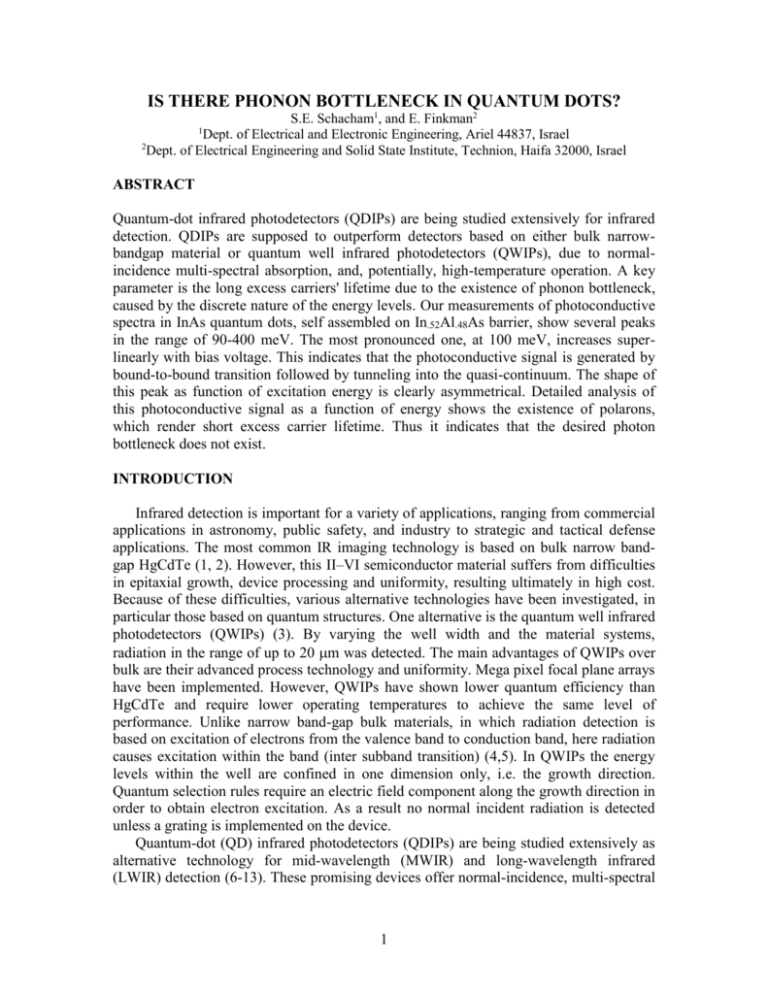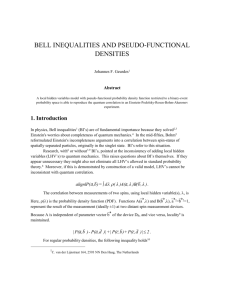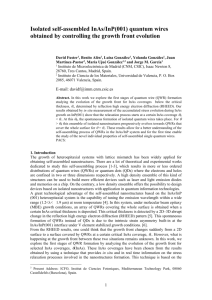Paper
advertisement

IS THERE PHONON BOTTLENECK IN QUANTUM DOTS?
S.E. Schacham1, and E. Finkman2
Dept. of Electrical and Electronic Engineering, Ariel 44837, Israel
2
Dept. of Electrical Engineering and Solid State Institute, Technion, Haifa 32000, Israel
1
ABSTRACT
Quantum-dot infrared photodetectors (QDIPs) are being studied extensively for infrared
detection. QDIPs are supposed to outperform detectors based on either bulk narrowbandgap material or quantum well infrared photodetectors (QWIPs), due to normalincidence multi-spectral absorption, and, potentially, high-temperature operation. A key
parameter is the long excess carriers' lifetime due to the existence of phonon bottleneck,
caused by the discrete nature of the energy levels. Our measurements of photoconductive
spectra in InAs quantum dots, self assembled on In.52Al.48As barrier, show several peaks
in the range of 90-400 meV. The most pronounced one, at 100 meV, increases superlinearly with bias voltage. This indicates that the photoconductive signal is generated by
bound-to-bound transition followed by tunneling into the quasi-continuum. The shape of
this peak as function of excitation energy is clearly asymmetrical. Detailed analysis of
this photoconductive signal as a function of energy shows the existence of polarons,
which render short excess carrier lifetime. Thus it indicates that the desired photon
bottleneck does not exist.
INTRODUCTION
Infrared detection is important for a variety of applications, ranging from commercial
applications in astronomy, public safety, and industry to strategic and tactical defense
applications. The most common IR imaging technology is based on bulk narrow bandgap HgCdTe (1, 2). However, this II–VI semiconductor material suffers from difficulties
in epitaxial growth, device processing and uniformity, resulting ultimately in high cost.
Because of these difficulties, various alternative technologies have been investigated, in
particular those based on quantum structures. One alternative is the quantum well infrared
photodetectors (QWIPs) (3). By varying the well width and the material systems,
radiation in the range of up to 20 m was detected. The main advantages of QWIPs over
bulk are their advanced process technology and uniformity. Mega pixel focal plane arrays
have been implemented. However, QWIPs have shown lower quantum efficiency than
HgCdTe and require lower operating temperatures to achieve the same level of
performance. Unlike narrow band-gap bulk materials, in which radiation detection is
based on excitation of electrons from the valence band to conduction band, here radiation
causes excitation within the band (inter subband transition) (4,5). In QWIPs the energy
levels within the well are confined in one dimension only, i.e. the growth direction.
Quantum selection rules require an electric field component along the growth direction in
order to obtain electron excitation. As a result no normal incident radiation is detected
unless a grating is implemented on the device.
Quantum-dot (QD) infrared photodetectors (QDIPs) are being studied extensively as
alternative technology for mid-wavelength (MWIR) and long-wavelength infrared
(LWIR) detection (6-13). These promising devices offer normal-incidence, multi-spectral
1
and potentially high-temperature operation. Like in QWIPs, the detection of radiation is
based on optical transitions between energy sub-levels within the conduction or valence
bands. However, unlike QWIPs, the energy confinement is in all three dimensions,
therefore discrete energy levels are formed. The requirement of radiation polarized along
the growth direction is waived. QDIPs have the potential of providing a higher detectivity
at higher operating temperatures. QDIPs have also been theoretically predicted to have
lower dark currents than other types of IR detectors due to three-dimensional quantum
confinement (14). Lower dark currents also increase the operating temperature of QDIPs,
since a signal-to-noise ratio (SNR) greater than one can be maintained at higher
temperatures.
The research of QDs was greatly advanced by the use of the Stranski– Krastanov
growth method. Using this relatively simple method, self assembled QDs with a narrow
size variance, and high surface coverage efficiency are grown using molecular beam
epitaxy, making use of the strain between lattice mismatched semiconductors (15, 16).
The detection process starts with photon absorption. The absorption coefficient in
quantum dots is affected by their size and shape, as well as the polarization of the
incident light. When IR photons impinge on quantum dots with energies greater than or
equal to the intersubband energy spacing, the photons may be absorbed by exciting
electrons from the ground state to the continuum of states above the dots or to an excited
shallow state. In the latter case the electrons must tunnel out of the excited level into the
continuum in order to contribute to the photocurrent. A photoexcited carrier can undergo
several processes. First, it can relax back into the ground state of the quantum dot. Since
the QDIP is a unipolar device, electron-hole scattering is greatly reduced, which is an
important relaxation process. The dominant relaxation mechanism should have been via
optical phonon emission. However, since the confined levels are of single energy, unless
the interlevel energy happens to coincide with that of the LO phonons, this process
cannot take place. This effect, known as the phonon bottleneck, leaves electron–electron
scattering as the dominant relaxation process, which is usually a much slower process.
Thus the effective excess carrier lifetime in quantum dot should be significantly longer
than in quantum wells, therefore a larger gain. This gain is defined in general as the ratio
of the carrier lifetime to carrier transit time, or alternatively, as the ratio of total collected
carriers to total excited carriers, both thermally generated and photogenerated. As in any
other photoconductor, it is useful to have gain, since it leads to higher photocurrent and
responsivity.
In spite of the theoretical advantages of QDIPs, implemented systems have shown, so
far, no clear advantage over other alternatives. One of the intriguing aspects is the issue
of the phonon bottleneck. Even though one group (17) reports the presence of this effect,
most other claim it is absent. Rather, relaxation times of the order of picoseconds were
measured (18-22).
The observed short relaxation times, in spite of the discrete energy levels, imply that
other relaxation mechanisms, rather than that involving a single LO phonon, are present.
It was suggested that electron with energies largely detuned from that of LO phonon can
relax via polarons (23-28), mixed modes formed by the strong coupling between the
electrons and phonons. The energy of the polarons may be significantly different from
that of the electrons, due to this strong coupling. Thus, in the presence of this mechanism,
there is no need for the two electron states to differ exactly by one LO phonon energy, i.e.
2
no phonon-bottleneck is present. The relaxation time of polarons is determined by the LO
phonon decay rate Г, by the detuning from the LO phonon energy Δ, and by the coupling
strength g between the electron and the LO phonons modes (25). Assuming an infinitely
deep confining potential for the conduction band electrons, the coupling strength for a dot
of size a (in nm), can be estimated by:
(1)
g 0.350 ( N B 1) / a
The LO phonon number is NB = [exp( 0 /kT)-1] -1. Assuming a constant phonon
decay rate Г for the confined LO modes, neglecting the LO phonons dispersion, the
relaxation time of the carriers in the QDs as a function of the detuning energy is given by
(24,25):
(2)
{ 2( R X )}1
2
2
2
2 2
where R=√(X +Y ), X=(g/h) +((Δ/h) -Г )/4, and Y=ГΔ/2h. Sauvage et al. (29) used this
model successfully to analyze their experimental decay time measurements with detuning
up to 19 meV from the LO phonon energy. This work was recently extended by Zibik et
al. for larger detuning energies (30). Based on the analysis of these line-shapes, as a
function of excitation energy, we introduce a novel method by which the dynamical
properties of the polaron decay are derived.
In this work the photoconductive (PC) signal, measured for an InAs/InAlAs quantum
dots array at various biases, is investigated. The analysis asymmetric line-shape as
function of energy should clarify the underlying relaxation mechanism and render the
observed relaxation time.
EXPERIMENTAL RESULTS
Photodetectors were implemented in the InAs/InAlAs/InP material system, with 10
layers of self-assembled InAs QDs, at a concentration of 7·1010 cm-2. The dots were
embedded in In.52Al.48As matrix, lattice matched to the InGaAs contact layers and the
semi-insulating InP (001) substrate. The dots were in a shape of elongated ellipsoids with
nominal dimensions of 50x30x1.7 nm3. The 50 nm thick InAlAs barrier was delta doped
in its center by Si at a sheet concentration of 5·10 11 cm-2, rendering an average number of
7 electrons per dot. Additional doping was inserted 25 nm below the bottom-most dot
layer and 25 nm above the upper-most dot layer, at a level of 2.5·1011 cm-2. The top and
bottom In.53Ga.47As contact layers were 0.5 μm thick, doped at concentrations close to
1019 cm-3. Buffer layers of not-intentionally-doped InAlAs were placed between the dot
structure and the contact layers, 100 nm thick at the bottom, and 25 nm thick at the top.
The detectors were implemented as square mesa structures, 200 μm on the side. Wedges
were implemented on the InP substrate along both [110] and 1 1 0 directions to enables
illumination with radiation polarized perpendicular to the layer in addition to polarization
along the width and length of the dots. Fig. 1 shows a schematic drawing of the mesa
structure and experimental configuration, along with AFM image of the QDs.
3
Front illumination
VB
10
0.5m InGaAs
20nm InAlAs n.i.d
20nm InAlAs n.i.d
20nm InAlAs n.i.d
Si n-doped 1018cm-3
δ dope Si 51011cm-2
InAs dot layer 71010cm-2
0.5m InGaAs n-81018cm-3
Semi-Insulating (100) InP
Wedge illumination
[-110]
y
x
x
[110]
Fig. 1: Top: Detector structure and illumination configurations. Bottom: AFM image of
uncapped sample with axes definition.
Measurements of Photoconductive (PC) spectra were performed using an FTIR
spectrometer. The spectra were measured for various biases, at temperatures ranging from
15 to 70 K. These spectra show several peaks ranging from 100 to 350 meV. The relative
intensities of the peaks depend on illumination configuration and polarization. The
expected PC spectrum for this structure was analyzed theoretically using a self-consistent
8-band k·p calculation. The theoretical results were in good agreement with the measured
data (31).
4
In this report we concentrate on the line-shape (photocurrent versus excitation energy)
of the dominant peak centered around 100 meV. Figure 2 shows the PC spectra of this
peak measured at 15 K for several forward biases.
Fig. 2: Photocurrent peak around 100 meV for several biases. Signal is asymmetric and
increases superlinearly.
ANALYSIS OF PC SPECTRA
The asymmetry of the peaks presented in Fig. 2 is apparent and intriguing. It indicates
that the energy at which relaxation is most effective, i.e. the phonon tuning energy, does
not coincide with the inter-sublevel energy spacing.
In QDIPs the current is generated by intraband transitions, in which the excitation of
carriers into the quasi-continuum is followed by their transport to the contacts due to the
electric field. The photocarriers can be excited directly from the confined sublevels into
the quasi-continuum. Alternatively, the carriers can be obtained through a two-stage
process, which combines the excitations of the carriers from a deep to a shallow bound
level, followed by tunneling across the slanted barrier into the quasi-continuum. The
superlinear increase of the PC current with bias for the 100 meV peak clearly indicates
that the excitation of electrons is into a shallow level followed by tunneling. This should
be contrasted with the other major peak centered around 290 meV which increases with
bias, as it is a result of direct excitation into the continuum. Accordingly we associated
these transitions with various energies involved in the excitation and relaxation processes,
as shown schematically in Fig. 3. Four confined levels within the dot Eground, E1, E2, and
E3 are shown. While the 290 meV broad peak is attributed to a direct transition from the
ground level Eground to the continuum, the PC signal around 100 meV is due to excitation
5
of carriers from the higher E1 level (which is below the Fermi level). The photon energy
E excites carriers from E1 to E4. While the absorption maximum should coincide with the
electronic transition Eo=E3-E1 , the peak of the PC signal does not appear at this energy,
as discussed below. The relaxation of the excited carries occurs in two steps. First, the
polaron decays from E4 into the intermediate level E2, and then from E2 to E1. The
presence of intermediate confined energy levels was recently confirmed by Fossard et al.
on a similar structure (32).
290 meV
E4
Δ
E2+ħωLO
E3
ħωLO
E2
Eo
Et
E
E1
Eground
Fig. 3: Schematic diagram QD energy levels associated with excitation and relaxation.
The photoconductive spectra, as a function of excitation energy E, were measured at
15 K for 4 different biases. The photoconductive current is given by I=qηφG where φ is
the photon flux. The gain G is proportional to the lifetime. The quantum efficiency η is
proportional to the absorption. The absorption is assumed to have a Gaussian distribution
around E3 due to size fluctuations of the dots. We fitted the line-shape to a model, which
includes the broadening of the excited level, tunneling out, and polaron relaxation time.
The PC line-shape of the 100meV peaks for the various biases were fitted to the
following expression:
A0 exp{ [( E E 0 ) 2 / W 2 ]}
(3)
6
with W the width of the Gaussian, and τ being the relaxation time as given by Eq. 2. The
fitting parameters were Ao, Eo, W, Γ the LO phonon decay rate, and the zero detuning
energy Et, with Δ = Et - E.
The same fitting parameters were used for all 4 biases with the exception of Ao the
normalization parameter. Ao is the only parameter that changes from one bias to the other.
Trying to include tunneling in this process did not improve the fitting results. Moreover,
since the line-shape is similar for all biases, with no change of peak position or linewidth, it is concluded that the influence of tunneling is negligible on this analysis. Also,
the exact value of the coupling strength g did not influence the convergence, and thus
could not be deduced from the fit. Thus g was taken as the value calculated from Eq. 1 to
be g = 3.7 meV and was not used as a fitting parameter.
Fig. 4: Line-shape fit for 100 meV peak for two biases. VB=0.75V curve is multiplied by
8 and shifted downwards for better comparison. Concave curve shows increase of polaron
lifetime with detuning.
Two of the measured spectra along with the results of the fitting are shown in Fig. 4.
The deduced values from all four fitted spectra for the significant physical parameters
are: E0 =102.7 meV, Et =108.8 meV, W=10.1 meV, and Γ=7.45 ps-1. The zero detuning
phonon lifetime of InAlAS was derived to be around 1.2 ps.
The measured PC current peak is clearly asymmetric at all biases. The polaron decay
time τ increases rapidly as the detuning energy Δ increases, as shown in Fig. 4. This effect
causes the asymmetric distortion of the Gaussian distribution of the absorption.
Moreover, the energy of the PC peak does not coincide with the energy of the center of
the excited level E0. Rather the peak is red shifted by 6 meV (located at 97 meV). This
7
shift is due to the prolonged relaxation time, as the detuning from the zero energy Et gets
larger. We assume that the relaxation time from E2 to E1 is much smaller than τ.
CONCLUSIONS
The important contribution of this work is the derivation of the dynamical properties
of intra-band transitions in quantum dots from the line-shape of the photoconductive
spectra. In particular, the definition of the zero detuning life-time using this method is
much simpler than deriving it from time resolved measurements. Polaron dynamics was
used to interpret recombination for energies much different than phonon energies, as was
done previously to interpret time resolved results (29, 30). The present results use the
same theoretical model but completely different experimental methods. The obtained
values are of the same magnitude as those obtained previously in InAs/GaAs QDs.
However, it should be noted that the dot shapes and energy levels are much different in
the present material system.
The exact energy dependence of the PC current was fitted by the increased polaron
lifetime with increased detuning. This high quality fit was achieved using the same fitting
parameters for all biases. The asymmetric line-shape was well accounted for. Moreover,
it was shown that the peak of the PC signal is red-shifted due to increased lifetime with
increased detuning. The excellent fit using the polaron model and the derived short
relaxation time indicate the absence of the desired phonon bottleneck.
REFERENCE
1. Baker I.M.and Maxey C.D., ‘Summary of HgCdTe 2D Array Technology in the U.K’.
.J. Electron. Mater. 30, 682-689 (2001).
2. Varesi J.B., Bornfreund R.E., Childs A.C., Radford W.A., Maranowski K.D., Peterson
J.M., Johnson S.M., Giegerich L.M., de Lyon T.J., Jensen J.E. ‘Fabrication of HighPerformance Large-Format MWIR Focal Plane Arrays from MBE-Grown HgCdTe on 4
Silicon Substrates’. J. Electron. Mater. 30, 566-573 (2001).
3. S. D. Gunapala and K. Bandara, Thin Solid Films 21, 113 (1995), and references
therein.
4. L. West and S. Eglash, Appl. Phys. Lett. 46, 1156 (1985).
5. B. Levine et al., Appl. Phys. Lett. 50, 1092 (1987).
6. K.W. Berryman, S. A. Lyon, and M. Segev, ‘Mid-infrared photoconductivity in InAs
quantum dots’. Appl. Phys. Lett., 70, 1861–1863 (1997).
7. J. Phillips, K. Kamath, and P. Bhattacharya, ‘Far-infrared photoconductivity in selforganized InAs quantum dots’. Appl. Phys. Lett., 72, 2020–2022 (1998).
8. S. Maimon, E. Finkman, G. Bahir, S. E. Schacham, J. M. Garcia, and P. M. Petroff,
‘Intersublevel transitions in InAs/GaAs quantum dots infrared photodetectors’. Appl.
Phys. Lett., 73, 2003–2005, (1998).
9. D. Pan, E. Towe, and S. Kennerly, ‘Normal-incidence intersubband (In, Ga)As/GaAs
quantum dot infrared photodetectors’. Appl. Phys. Lett., 73, 1937–1939 (1998).
10. S. Sauvage, P. Boucaud, J. M. Gérard, and V. Thierry-Mieg, ‘In-plane polarized
intraband absorption in InAs/GaAs self-assembled quantum dots’. Phys. Rev. B 58,
10562–10567 (1998).
8
11. S. J. Xu, S. J. Chua, T. Mei, X. C.Wang, X. H. Zhang, G. Karunasiri,W. J. Fan, C. H.
Wang, J. Jiang, S. Wang, and X. G. Xie, ‘Characteristics of InGaAs quantum dot infrared
photodetectors’. Appl. Phys. Lett., 73, 3153–3155 (1998).
12. Q. D. Zhuang, J. M. Li, H. X. Li, Y. P. Zeng, L. Pan, Y. H. Chen, M. Y. Kong, and L.
Y. Lin, ‘Intraband absorption in the 8–12 _m band from Si-doped vertically aligned
InGaAs/GaAs quantum-dot superlattice’. Appl. Phys. Lett., 73, 3706–3708 (1998).
13. L. Chu, A. Zrenner, G. Böhm, and G. Abstreiter, ‘Normal-incident intersubband
photocurrent spectroscopy on InAs/GaAs quantum dots’. Appl. Phys. Lett., 75, 3599–
3601, (1999).
14. V. Ryzhii, ‘The theory of quantum-dot infrared phototransistors,’ Semiconduct. Sci.
Technol., 11, 759–765 (1996).
15. D. Leonard, M. Krishnamurthy, C. M. Reaves, S. P. Denbaars, and P. M. Petroff,
'Direct formation of quantum-sized dots from uniform coherent islands of InGaAs on
GaAs surfaces'. Appl. Phys. Lett., 63, 3202–3204 (1993).
16. D. Bimberg, M. Grundmann, and N. N. Ledenstov, 'Growth, spectroscopy and laser
application of self-ordered III-V quantum dots'. Mater. Res. Soc. Bull. 23, 31, (1998).
17. J. Urayama, T. B. Norris, J. Singh, and P. Bhattacharya, ‘Observation of phonon
bottleneck in quantum dot electronic relaxation’. Phys. Rev. Lett. 86, 4930–4933, (2001).
18. B. Ohnesorge, M. Albrecht, J. Oshinowo, A. Forchel, and Y. Arakawa, Phys. Rev. B
54, 11532 (1996).
19. M. J. Steer, D. J. Mowbray, W. R. Tribe, M. S. Skolnick, M. D. Sturge, H.
Hopkinson, A. G. Cullis, C. R. Whitehouse, and R. Murray, Phys. Rev. B 54, 17738
(1996).
20. U. Bockelmann, W. Heller, A. Filoramo, and Ph. Roussignol, Phys. Rev. B 55, 4456
(1997).
21. R. Heitz, M. Veit, N. N. Ledentsov, A. Hoffman, D. Bimberg, V. M. Ustinov, P. S.
Kop'ev, and Zh. I. Alferov, Phys. Rev. B 56, 10435 )1997(.
22. U. Bockelmann and T. Egeler, Phys. Rev. B 46, 15574 (1992).
23. T. Inoshita and H. Sakaki, Phys. Rev. B 56, R4355 (1997).
24. X. Q. Li and Y. Arakawa, Phys. Rev. B 57, 12 285 (1998).
25. X. Q. Li, H. Nakayama, and Y. Arakawa, Phys. Rev. B 59, 5069 (1999).
26. S. Hameau, Y. Guldner, O. Verzelen, R. Ferreira, G. Bastard, J. Zeman, A. Lemaitre,
and J. M. Gérard, Phys. Rev. Lett. 83, 4152 )1999(.
27. O. Verzelen, R. Ferreira, and G. Bastard, Phys. Rev. B 62, R4809 (2000).
28. O. Verzelen, R. Ferreira, and G. Bastard, Phys. Rev. B 64, 075315 (2002).
29. S. Sauvage, P. Boucaud, R.P.S.M. Lobo, F. Bras, G. Fishman, R. Prazeres, F. Glotin,
J.M. Ortega, J. M. Gerard, Phys. Rev. Lett. 88, 177402, (2002).
30. E. A. Zibik, L. R. Wilson, R. P. Green, J-P. R. Wells, P. J. Phillips, D. A. Carder, J.
W. Cockburn, M. S. Skolnick, J. M. Steer, H. Y. Liu, and M. Hopkinson, 'Polaron
relaxation dynamics in InAs/GaAs self-assembled quantum dots'. Physica E 21, 405-408
(2004).
31. S.E. Schacham, W. Sheng, J.P. Leburton, F. Fossard, F.H. Julien, M. Gendry, E.
Finkman, N. Shuall and G. Bahir, Phys. Rev. B 68, 41309 (2003).
32. F. Fossard, A. Helman, G. Fishman, F. H. Julien, J. Brault, M. Gendry, E. Péronne,
A. Alexandrou, S. E. Schacham, G. Bahir and E. Finkman, Phys. Rev. B 69, 155333
(2004).
9




